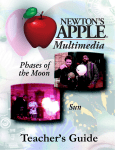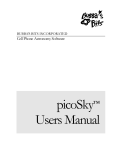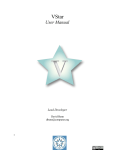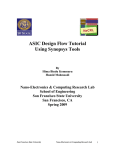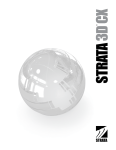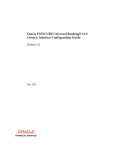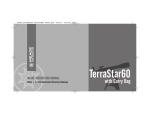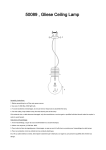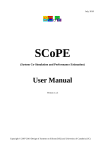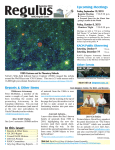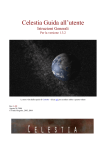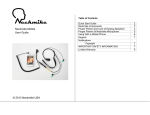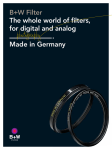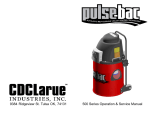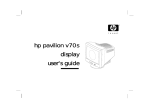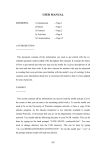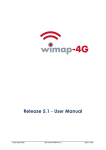Download Discovery Dome Teacher`s User Manual Columbus City Schools
Transcript
Discovery Dome Teacher’s User Manual Columbus City Schools Science Department For more information and CCS video Tutorials go to the CCS Science Department Website Columbus City Schools Curriculum Leadership & Development Science Department June 2012 Page 1 Discovery Dome Teacher’s User Manual Table of Contents Discovery Dome Introduction………………………………....................................... 3 Discovery Dome Introductory Letter to Parents……………………………………… 4 Discovery Dome Set-Up Directions with Photos…………………………………….. 5 Discovery Dome Inventory Check List……………………………………………….. 9 Discovery Dome Accommodations for Physically Challenged……………….......... 10 Discovery Dome Rules and Safety Regulations…………………………………….. 11 Discovery Dome Expectations………………………………………………………… 12 Discovery Dome To-Do Check List…………………………………………………… 13 Discovery Dome Inspection Sheet……………………………………………………. 14 Discovery Dome Video Information & Reviews....................................................... 15 Discovery Dome Picture Information….………………………………………………. 31 Discovery Dome Media Player 3.96 Button #86 Space Images……………………. 33 Discovery Dome Media Player 3.96 Button #91 Space Images………………........ 34 Discovery Dome Sample Lesson Example Dialogue………………………………. 35 Discovery Dome Professional Learning Community Sample Dialogue….………… 38 Collaborative Conversations (Common Core ELA State Standards)………………. 41 Movie Information Earth’s Wild Ride Two Small Pieces of Glass: The Amazing Telescope IBEX: Search for the Edge of the Solar System Saturn: The Ring World Columbus City Schools Curriculum Leadership & Development Science Department June 2012 Page 2 Discovery Dome Introduction Greetings and welcome to the exciting world of Discovery Dome! The Discovery Dome was purchased by the Columbus City Schools in the fall of 2011, to help bring science concepts to life and to give teachers and students a new way of exploring our Earth and the Universe that surrounds us. The Discovery Dome is a portable, inflatable planetarium that allows teachers to show star constellations, space phenomena, as well as science videos in a 360 degree format. The Discovery Dome is different from the two Star Labs that the school district currently possesses. This isn't your old crawl-in star dome! It offers a fully portable digital theater with true HD, with full dome movies and zoom-in digital star fields. With support from NASA REASoN and a strong partnership with museums and universities, the Discovery Dome brings the excitement of museum-quality shows, presenting a wide range of educational topics. Before being able to use the Discovery Dome, teachers will need to complete two different training sessions. The training sessions will instruct teachers the proper usage of the dome, set-up and take down procedures, as well as the use of the software involved in running the different programs. This user manual contains many different sections in the general usage of the Discovery Dome. Also included, are lessons that can be used before, during and after students experience the Discovery Dome. Be sure to read through this manual in detail, as the usage of the Discovery Dome is much more technical than the Star Lab. If there are any questions, or would like to receive training, please contact the Columbus City Schools Science office at 365-5297. "Astronomy compels the soul to look upwards and leads us from this world to another." (Plato) Columbus City Schools Curriculum Leadership & Development Science Department June 2012 Page 3 INTRODUCTORY LETTER TO PARENTS Dear Parents, Our class will be engaged in learning science through the Discovery Dome interactive planetarium. The Discovery Dome is a portable, inflatable planetarium that students will be going into to learn about our Earth and the Universe that surrounds us. Inside of the dome, students will experience a 360 degree presentation on a variety of Science topics and concepts that they are studying in science class. This will be an exciting experience for your child! We are confident the following benefits will result from your child’s participation in the Discovery Dome: Reinforcement of grade level science content and practices Fostering curiosity, awareness, and creativity Increased scientific knowledge Growth in ability to understand phenomena and science in the world around us. Having fun with science! In addition to the opportunity to visit and participate in the Discovery Dome, your student will be working on several grade level specific lessons that coincide with what they will be observing in the Discovery Dome. These lessons will provide the students with an increased awareness of science and an opportunity to apply their newly obtained knowledge through hands-on activities. The science activities allow children to use critical thinking and problem solving skills. If you have any further questions, feel free to contact your student’s science teacher. “Science is not merely a collection of facts printed in an encyclopedia. It is a living adventure of the human spirit.” (Source Unknown). Columbus City Schools Curriculum Leadership & Development Science Department June 2012 Page 4 Discovery Dome Set-Up Directions Space Requirement: 12 foot ceiling w/o obstructions (i.e. ceiling fans, lights or vents) 20x20 foot area on a clean floor. Be sure to sweep the area that will be exposed to the dome. The gray area (inside) of the dome needs to be kept clean. Nearby power source 16.5' Optional Seating folding chairs for adult seating Newtonian -2 Mirror projection system positioned near the rear wall; small footprint 23" x 15" b Air Blower Airlock Door Continuous entry and exist without disrupting the presentation or deflating the dome; wheelchair accessible 4' System Operator Chair, stool, or sitting on the floor next to projection system. Setting Up: 1. Unzip the dome bag with dome door facing front. 2. Unroll the dome away from dome door. 3. If needed, re-position the dome when slightly inflated. 4. Tilt the blower upright then attach the hose to the blower (fan), and secure with the Velcro. 5. Turn the blower on high and hold the entrance door at the seam of the dome until it inflates. 6. Once the dome is fully inflated, you can use the light stick and hang it near the doorway entrance. Columbus City Schools Curriculum Leadership & Development Science Department June 2012 Page 5 Supplies: 1. Put the following items in the dome by sliding under the inflated dome: Newtonian-minus cover, laptop, storage container, at least one chair, and flashlight from storage container. 2. Enter the dome with the flashlight sideways. 3. Hang the flashlight on the fixture above the doorway. 4. Assemble the portable stand from the storage container; all of the legs must be same length, fit the notch into the groove and screw tightly with fingers. 5. Position the stand twelve inches from the back wall and twelve inches left of the air vent. 6. Place the Newtonian on the stand, and open the lid by unscrewing the knob and pull out; then extend the side panels outward. 7. Place the projector sideways into the Newtonian, DO NOT TOUCH THE MIRROR!! 8. Connect the projector cables (power to source, and laptop cable), then turn on the projector. Columbus City Schools Curriculum Leadership & Development Science Department June 2012 Page 6 9. Attach the smaller secondary flat mirror to sliding shelf (roughly 8 inches) from projector. Small Mirror 8 inches from projector 10. Take the cap off of the projector’s lens. 11. Turn on the laptop (Password=science). 12. Double check that the WIFI access button is red (located next to the DVD player port on the right hand side of the computer). Opening the Program: 1. Click the Media Show 3.96 Icon (top portion of the home screen). 2. At the top of the screen a Red Tool bar will appear, at the top left corner click on Load Set. 3. A new screen will pop up, click on Columbus Set. 4. Different media shows will appear in top right of tool bar, click on chosen video segment. 5. You may also use the left and right arrow buttons to cycle through the videos. 6. Several of the links are either images or segments of videos. Be sure to click on the program that you want to use. (It is recommended to already know what you want to show your students). 7. (Stellarium, Celestia, and Telescope) are programs that can also be run without using the Media Show 3.96. If you want to use one of these programs, click on the icon on the computer’s main screen. Audio Set Up: 1. Carefully take out Bose surround sound system and labeled wires. (Black box, 2 small speakers, volume controller, and labeled cables.) 2. On the back of the Bose speaker system, plug in the labeled power cord to the bottom port (AC input). 3. Connect the Volume Controller (control pod) to the second port from the bottom. 4. In the third port from the bottom, connect the Sound Box cord to the laptop-plug into the headphone port on the right side of the computer (make sure switch is turned ON on the sound box). 5. Connect each individual Bose speaker, to the left and right ports. 6. Adjust base compensation knob to preference. Columbus City Schools Curriculum Leadership & Development Science Department June 2012 Page 7 Alignment: Set up in following order: Flat Mirror, Spherical Mirror, Dome 1. Start Media Show-Mirror; load a button set; select the grid image (button #100). 2. Adjust the projectors zoom full out (small image not large and close up). 3. Adjust vertical position of the flat mirror so that the projected frame is approximately 1” down from the top edge of the mirror. Depending on the projector, sometimes the height of the projector feet must be increased. 4. Adjust the focus. 5. Adjust the flat mirror tilt-bottom ring of the grid is approximately ½” above the bottom edge of the spherical mirror. 6. Adjust the Newtonian lid (usually tilting forward) to position the projected horizon approximately 3 to 4 feet above the floor. Final Checks: 1. Projected image should not be over the top of the flat mirror. 2. Projected image should not be below the convex mirror. 3. Media Show menu strip (red) should be slightly above the top of the spherical mirror. 4. Adjust projector focus as necessary. Packing-Up 1. Turn off all of the equipment and take down the Newtonian mirror and projector. 2. Place the Flat mirror into its respective case. 3. Move the equipment to the center of the dome. 4. Face the door while inside of the dome and grab the dome near the bottom rim. Pull the bottom of the dome carefully but yet quickly over your head to settle letting the air out. 5. Turn off the Dome Fan. 6. Unplug the projector, computer and put in their respective case. Place the computer power cord in the Computer Bag. 7. Place the USB wire and projector power cord into the “Projector Wire Bag”. 8. Disconnect the audio wires from the sound system. Place the audio wires into the “Sound Wire Bag”. 9. To pack the equipment into the case, put the Sound Box on the side with the wheels. 10. The other equipment can be placed into the case accordingly. (Be careful with the Flat Mirror) 11. Place the table onto the top of the materials once everything else is packed into the case. 12. Place the equipment onto the cart. Columbus City Schools Curriculum Leadership & Development Science Department June 2012 Page 8 Discovery Dome Inventory Check List Audio Equipment Black box speaker 2 small speakers Volume control knob Sound box to laptop wire Power Cord for sound system Dome Small Newtonian mirror with case Big mirror in hard case Table with collapsible legs Dome Tent Fan Optima projector and case with power cord and USB cable Accessories Large flashlight (light stick) 2 small flashlights Extension cord Black surge protector 2 adaptors for large flashlight (light stick) Orange bag containing Dome patch kit Laptop Dell laptop and case Power Cord Columbus City Schools Curriculum Leadership & Development Science Department June 2012 Page 9 Discovery Dome Accommodations for Special Needs Students Because of its unique design, the Discovery Dome can accommodate visitors who are restricted to wheelchairs, have walkers or have special needs. Instead of having these individuals use the entrance door, they can enter and exit the planetarium by going in and out under the edge of the dome. Individuals who have special needs should be brought into the dome before the rest of the visitors. Begin by turning up the fan to the highest setting so that the Discovery Dome becomes overinflated and starts lifting off of the floor. Remove anything from the inside of the dome that maybe in contact with the edge. Maneuver the individual to the side of the planetarium opposite the point where the entrance and inflation tubes attach to the dome. With the help of a second person, lift the side of the Discovery Dome, and roll the person in the wheelchair under the material toward the center of the dome. Drop the side of the dome back down behind the person and allow the dome to re-inflate. Once the dome has fully inflated, have the rest of the students enter the dome through the entrance door. Have the last person entering turn the fan to the lowest setting. Have the person in the wheelchair then sit near the entrance door. Once the lesson is over, allow the rest of the group to leave and then remove the person in the wheelchair the same way that they were brought in. Columbus City Schools Curriculum Leadership & Development Science Department June 2012 Page 10 Discovery Dome Safety Rules & Regulations 1.) No Shoes are allowed inside of the Discovery Dome. 2.) Participants should be wearing socks. 3.) No Food, Drinks, or Gum are allowed inside of the Discovery Dome. 4.) No pencils, pens, or sharp objects. 5.) No touching of the walls with feet or hands. 6.) No touching of the Discovery Dome equipment other than by a trained individual. 7.) Do not set the Discovery Dome near a heat source such as an incandescent light bulb or heater. This will damage the Dome. 8.) Have at least two working flashlights / L.E.D. Utility Lights (Make sure the L.E.D. Utility Lights are fully charged before use.) 9.) Do not leave the equipment in the Discover Dome unattended or protected when not in use. (The Dome may still be setup while projection equipment is removed.) 10.) During the non-use of the Discovery Dome, turn the LCS projector off. 11.) Do not set up the Discovery Dome outside, the Discovery Dome is for inside use only. 12.) During non-use of Discovery Dome, turn the LCD projector off. 13.) Do not set up the Discover Dome outside! The Discovery Dome is for inside use only. 14.) Dome Trained Teacher should always be the first person in and out of the Dome. (No students should be alone in the Dome) 15.) Always make sure there is a clear path out of the Dome in the event in of an emergency. 16.) Never set up the Dome at the edge of the stage where individuals could possibly fall off. 17.) In case of Dome deflation, check the fan and electric cord. If the fan cannot be restarted, please evacuate students. 18.) In case of an emergency, have the trained teacher lift up the side of the Dome for immediate exit. Do not use the entry/exit tunnel in an emergency. Columbus City Schools Curriculum Leadership & Development Science Department June 2012 Page 11 Discovery Dome Expectations 1.) Due to the shape of the Discovery Dome, voices are amplified similar to a microphone effect. There should be no talking while inside of the Discovery Dome. 2.) Presentations in the Dome may cause motion sickness, precautions should be taken. (i.e. Imax Theaters) 3.) Students should be seated as far away as possible from the Dome equipment. (Students should sit a minimum of one foot from the Dome all and equipment.) 4.) When students are entering/exiting, it is very important that the teacher MUST be in charge AT ALL TIMES and protect the equipment. (Do not assign a student to be in charge of Discovery Dome setup/take down and protection of equipment. 5.) Suggested seating for students for the following activities: a. Movies-all students should be seated with their backs to the “equipment” wall (Near the door). b. Star-field activities-all students should sit around the perimeter of the Discovery Dome with their backs to the wall of the Dome. 6.) CCS approved programs already exist on the Discovery Dome computer. Please do not download or use personal flash drives to load program to the Discovery Dome laptop. Feel free to contact the Science Department if you find a great program to include on the Discovery Dome computer. The Science Department will be happy to review it. **Review all expectations with students. Columbus City Schools Curriculum Leadership & Development Science Department June 2012 Page 12 Discovery Dome To-Do Checklist For use PRIOR to the Discovery Dome Session: o Determine where the Discovery Dome will be located: ____ Gym: (check for schedule conflicts) ____ Lunchroom: Arrange for breakfast and lunch to be eaten in classrooms if need be. ____ Auditorium: Arrange for changes in classes and activities if need be. o Notify the office and custodians of the position of the Discovery Dome. o Send the Discovery Dome Parent Letter home with your students. o Arrangements have been made for pick up/return of Discovery Dome ___ Pick up person _________________ ___ Date of Pick up _________________ ___ Return person _________________ ___ Date of return _________________ Suggestions: o Determine set up time __________________ o Determine take down time __________________ o Create a Schedule of classes involved o Invite parents to participate as volunteers o Become familiar with suggested lessons and included programs. Columbus City Schools Curriculum Leadership & Development Science Department June 2012 Page 13 Discovery Dome Inspection Sheet Upon receiving the Discovery Dome, it is important to inspect all of the equipment to be certain that it is in working order and in place. Please place a check or mark in the box to indicate that each piece of equipment is in satisfactory condition. If there are any problems with an item, please list in the appropriate box and notify the Science Department. Teacher Name_________________________________School________________________ Pick Up Date _______________ Equipment Title Pack Up Date _______________ Pick-Up Packed-Up Bose Black Box Speaker 2 Small Bose Speakers Volume Control Knob Sound Box to Laptop Wire Power Cord for Sound System Small Newtonian mirror w/case Large Newtonian mirror in hard case Table w/ 4 collapsible legs Fan w/extension cord LCD Projector w/ power cord & USB cable Large Flashlight (Light Stick) 2 Small Flashlights Extension Cord Black Surge Protector 2 adaptors for Large Flashlight Dell Computer & Case Dell Computer Power Cord Discovery Dome Columbus City Schools Curriculum Leadership & Development Science Department June 2012 Page 14 Discovery Dome Video/Picture Information & Reviews Earth’s Wild Ride Produced in collaboration with Rice University, through NASA's Immersive Earth Project. Imagine Earth were a distant place you once called home but could never visit again. What would you remember most about the planet, and how would you describe it to your grandchildren? Set on the surface of the Moon in the year 2081, a grandfather and granddaughter watch a solar eclipse from scenic cliffs overlooking their moon colony. Conversation leads to contrasts between the moon, the only home the granddaughter knows, and the Earth, where the grandfather has spent most of his life. As they watch the Moon's shadow move across Earth, the grandfather tells stories of crashing asteroids, erupting volcanoes, roaring dinosaurs, electrifying lightning and booming thunder. Each experience begins with a telescope view of the dynamic Earth in stark contrast with the unchanging lunar landscape. “Earth's Wild Ride” is like many tales shared by grandparents over the centuries, except "the old country" is really another planet, always visible from the moon base, but totally unlike the granddaughter's world. While learning about eclipses, the ice age, Earth's water cycle and differences between the Earth and Moon, the audience is taken on a roller-coaster-like ride through canyons of raging rivers and hot flowing lava. Adventure and appreciation for home fill this 20-minute journey back to the Earth. Grade Level: 2nd through 8th Running Time: 20 minutes Columbus City Schools Curriculum Leadership & Development Science Department June 2012 Page 15 Movie Reviews: Feel free to write down your opinion of the movie, and what grade level it is appropriate for. Name: Eric S. School: Ridgeview MS Grade Taught: 7th My students overall enjoyed Earth’s Wild Ride. The video is geared towards elementary students, (grades 3-5) but my seventh graders were very entertained. The movie correlates to the seventh grade curriculum when it has several parts about volcanoes, eclipses, and water. Earth’s Wild Ride is recommended if you want to show the “coolness” of the Discovery Dome, however it is not the greatest way to teach content. Recommendations: To support the development of Science concepts with Earth’s Wild Ride, I would teach several of the lessons that are included in this User’s Manual or are on the Science Department website. Name:______________________School:___________________ Grade Level Taught: ________ Recommendations: Columbus City Schools Curriculum Leadership & Development Science Department June 2012 Page 16 Feel free to write down your opinion of the movie, and what grade level it is appropriate for. Name:___________ School: ______________________ Grade Taught: Recommendations: Name:______________________School:___________________ Grade Level Taught: ________ Recommendations: Columbus City Schools Curriculum Leadership & Development Science Department June 2012 Page 17 Feel free to write down your opinion of the movie, and what grade level it is appropriate for. Name:___________ School: ______________________ Grade Taught: Recommendations: Name:______________________School:___________________ Grade Level Taught: ________ Recommendations: Columbus City Schools Curriculum Leadership & Development Science Department June 2012 Page 18 Two Small Pieces of Glass-The Amazing Telescope While attending a local star party, two students learn how the telescope has helped us understand our place in space and how telescopes continue to expand our understanding of the Universe. Their conversation with a local astronomer enlightens them on the history of the telescope and the discoveries these wonderful tools have made. The students see how telescopes work and how the largest observatories in the world use these instruments to explore the mysteries of the universe. While looking through the astronomer's telescope, the students, along with the planetarium audience, explore the Galilean Moons, Saturn's rings, and spiral structure of galaxies. During their conversation with the astronomer, they also learn about the discoveries of Galileo, Huygens, Newton, Hubble and many others. Engaging and appealing to audiences of all ages, Two Small Pieces of Glass traces the history of the telescope from Galileo's modifications to a child's spyglass-using two small pieces of glass-to the launch of NASA's Hubble Space Telescope and the future of astronomy. It explores the wonder and discovery made by astronomers throughout the last 400 years. Grade Level: All Ages Running Time: Appx. 23 minutes Columbus City Schools Curriculum Leadership & Development Science Department June 2012 Page 19 Movie Reviews: Feel free to write down your opinion of the movie, and what grade level it is appropriate for. Name: Eric S. School: Ridgeview MS Grade Taught: 7th Two Pieces of Glass is a great way to introduce the creation of telescopes to students. Its presentation is awe inspiring as the 360 degree format is mesmerizing to anyone observing. The movie is geared to all ages and focuses much of its time on space and star exploration. My students really enjoyed it!!!!! Recommendations: To support science concepts in this movie, I recommend using the program Stellarium to help students extend knowledge of stars and constellations. Name:______________________School:___________________ Grade Level Taught: ________ Recommendations: Columbus City Schools Curriculum Leadership & Development Science Department June 2012 Page 20 Feel free to write down your opinion of the movie, and what grade level it is appropriate for. Name:___________ School: ______________________ Grade Taught: Recommendations: Name:______________________School:___________________ Grade Level Taught: ________ Recommendations: Columbus City Schools Curriculum Leadership & Development Science Department June 2012 Page 21 Feel free to write down your opinion of the movie, and what grade level it is appropriate for. Name:___________ School: ______________________ Grade Taught: Recommendations: Name:______________________School:___________________ Grade Level Taught: ________ Recommendations: Columbus City Schools Curriculum Leadership & Development Science Department June 2012 Page 22 IBEX- Search for the Edge of the Solar System This movie is for observers with an appreciation for the challenges of space science and a desire to learn more about science research, IBEX: Search for the Edge of the Solar System follows the creation of NASA's Interstellar Boundary Explorer (IBEX). Audiences will get an in-depth look at the mission and how IBEX is collecting high-speed atoms to create a map of our Solar system and beyond. IBEX is narrated by two curious teenagers; audiences will hear from the scientists and engineers that developed the IBEX mission and created the spacecraft, and get the latest updates on the mission's discoveries. It also introduces the basics to our solar system and the Universe around us. Grade Level: Upper Middle School & High School Students Running Time: Approximately 28 minutes Columbus City Schools Curriculum Leadership & Development Science Department June 2012 Page 23 Movie Reviews: Feel free to write down your opinion of the movie, and what grade level it is appropriate for. Name: Eric S. School: Ridgeview MS Grade Taught: 7th IBEX is a very technical and detailed oriented video. At times the content can be a little dry and would be very difficult for younger viewers. It does have some interesting information about the IBEX space probe, however, I found it to be boring. I would recommend watching Two Pieces of Glass if your class is going to be learning about exploring the Solar System. Recommendations: To help support science concepts using this movie consider going to the website, http://ibex.swri.edu/ for a great deal of information the IBEX space probe. Name:______________________School:___________________ Grade Level Taught: ________ Recommendations: Feel free to write down your opinion of the movie, and what grade level it is appropriate for. Columbus City Schools Curriculum Leadership & Development Science Department June 2012 Page 24 Name:___________ School: ______________________ Grade Taught: Recommendations: Name:______________________School:___________________ Grade Level Taught: ________ Recommendations: Columbus City Schools Curriculum Leadership & Development Science Department June 2012 Page 25 Feel free to write down your opinion of the movie, and what grade level it is appropriate for. Name:___________ School: ______________________ Grade Taught: Recommendations: Name:______________________School:___________________ Grade Level Taught: ________ Recommendations: Columbus City Schools Curriculum Leadership & Development Science Department June 2012 Page 26 Saturn- The Ring World II Saturn is the true "Lord of the Rings". After nearly seven years in transit, the two-story Cassini-Huygens spacecraft began orbiting Saturn on July 1, 2004. Cassini continues to explore Saturn and its moons during its extended mission, while the Huygens probe had landed on the surface of Titan, Saturn's largest moon. The Cassini Saturn encounter began with a flyby of Saturn's farthest moon, Phoebe. In Saturn-The Ring World II viewers will get an up-close and personal experience with one of the universes most popular planets. Ring World is narrated by Star Trek's John Billingsley (Dr. Phlox on ENTERPRISE) and was produced by NASA's Jet Propulsion Laboratory. Grade Level: Middle School and High School Students Running Time: Appx. 23 minutes Columbus City Schools Curriculum Leadership & Development Science Department June 2012 Page 27 Movie Reviews: Feel free to write down your opinion of the movie, and what grade level it is appropriate for. Name: Eric S. School: Ridgeview MS Grade Taught: 7th Saturn-The Ring World II chronicles the Cassini-Huygens Spacecraft as it travels through our Solar System and around Saturn and its different moons. The movie discusses the composition of Saturn’s different moons and the conditions on Saturn itself. The video is primarily computer generated which leads to some amazing renderings of the ringed planet. I did find the video to be higher level and very detailed. Many students would find it interesting, but teacher would need to have supplemental information to help water the content down. Recommendations: When using this movie, a good source for supplemental info is http://nineplanets.org/saturn.html http://solarsystem.nasa.gov/planets/profile.cfm?Object=Saturn Name:______________________School:___________________ Grade Level Taught: ________ Recommendations: Feel free to write down your opinion of the movie, and what grade level it is appropriate for. Columbus City Schools Curriculum Leadership & Development Science Department June 2012 Page 28 Name:___________ School: ______________________ Grade Taught: Recommendations: Name:______________________School:___________________ Grade Level Taught: ________ Recommendations: Columbus City Schools Curriculum Leadership & Development Science Department June 2012 Page 29 Feel free to write down your opinion of the movie, and what grade level it is appropriate for. Name:___________ School: ______________________ Grade Taught: Recommendations: Name:______________________School:___________________ Grade Level Taught: ________ Recommendations: Columbus City Schools Curriculum Leadership & Development Science Department June 2012 Page 30 Discovery Dome Media Player Picture & Feature Information Inside of the Media Player 3.96, there are several pictures and trailers that can be viewed when in the Discovery Dome. Below is a review of the way to observe the movies and pictures. Also included is a short synopsis for each of the pictures. 1. Click the Media Show 3.96 Icon (top portion of the home screen). 2. At the top of the screen a Red Tool bar will appear, at the top left corner click on Load Set. 3. A new screen will pop up, click on Columbus Set. 4. Different media shows will appear in top right of tool bar, click on chosen video segment. 5. You may also use the left and right arrow buttons to cycle through the videos. 6. Several of the links are either images or segments of videos. Be sure to click on the program that you want to use. (It is recommended to already know what you want to show your students). 7. (Stellarium, Celestia, and Telescope) are programs that can also be run without using the Media Show 3.96. If you want to use one of these programs, click on the icon on the computer’s main screen. Picture Information: Focus Image (100) is used for adjusting your Newtonian mirrors and LCD Projector. To adjust the focus, manipulate the LCD Projector and re-position the different mirrors. (Follow the steps in the Set-Up Section) Planets (99) is a button that can be used as an image that can be displayed on the interior of the dome. This image can be up on the dome as students walk in and get seated for the presentation. The image portrays the eight planets in our Solar System. Apollo (98) is a button that can be used as an image that can be displayed on the interior of the dome. This image can be up on the dome as students walk in and get seated for the presentation. The image portrays the moonscape of our Moon during one of the Apollo missions. St. Peters (97) is a button that can be used as an image that can be displayed on the interior of the dome. This image can be up on the dome as students walk in and get seated for the presentation. The image portrays the interior of St. Peter's Basilica in Vatican City. Columbus City Schools Curriculum Leadership & Development Science Department June 2012 Page 31 Petra (96) is a button that can be used as an image that can be displayed on the interior of the dome. This image can be up on the dome as students walk in and get seated for the presentation. Petra is a historical and archaeological city in the Jordanian governorate of Ma'an that is famous for its rock cut architecture and water conduit system. Life of a Star Sequence (91) is a button that has twenty-three images of stars in different phases of their life sequence. See the following pages for title names. ISS (90) is a button that can be used as an image that can be displayed on the interior of the dome. This image can be up on the dome as students walk in and get seated for the presentation. The image shows to astronauts working on the International Space Station. I would not recommend using this button because one of the astronauts does not have his shirt on in the picture. Trailers & Enchanted Reef Trailers (89 & 88) are buttons that are showing products which are available for purchase for the Discovery Dome. Time Telescope (87) is a button that shows several unidentified star images. Target Image Sequence (86) is a button that has eighty-six images of stars in different phases of their life sequence. Many of the buttons have a title, however some are not titled. Columbus City Schools Curriculum Leadership & Development Science Department June 2012 Page 32 Media Player 3.96 Button #86 Space Images 1.) Doradus 29.) Hyades 58.) No title 2.) Tucanae 30.) Lagoon Nebula 59.) No title 3.) Abell 31.) Leo Minor 60.) No title 4.) Abell 32.) LMC 61.) No title 5.) No title 33.) Lynx 62.) No title 6.) Antennae Galaxies 34.) Lynx 63.) No title 7.) Arches Cluster 35.) No title 64.) No title 8.) Beta Pictoris 36.) No title 65.) No title 9.) Betelgeuse 37.) No title 66.) No title 10.) Boomerang Nebula 38.) No title 67.) No title 11.) Cartwheel Galaxy 39.) No title 68.) No title 12.) Milkway Center 40.) No title 69.) No title 13.) Crab Nebula 41.) No title 70.) No title 14.) Dumbbell Nebula 42.) No title 71.) Orion Nebula 15.) Eagle Nebula 43.) No title 72.) Pistol Star 16.) Egg Nebula 44.) Massive Open Cluster 73.) Pleiades 17.) Eskimo Nebula 45.) No title 74.) Polaris A & B 18.) Eta Carinae 46.) No title 75.) Proxima Centauri 19.) No title 47.) No title 76.) Retina Nebula 20.) Gliese 48.) No title 77.) Sirius A & B 21.) Gravity Lens 49.) No title 78.) No title 22.) Gum Nebula 50.) No title 79.) No title 23.) No title 51.) No title 80.) No title 24.) Helix Nebula 52.) No title 81.) Sun 25.) Hodge 53.) No title 82.) Triffid Nebula 26.) Horsehead Nebula 54.) No title 83.) No title 27.) Hourglass Nebula 55.) No title 84.) No title 28.) Hubble Telescope 56.) No title 85.) No title 57.) No title 86.) No title Deep Field Columbus City Schools Curriculum Leadership & Development Science Department June 2012 Page 33 Media Player 3.96 Button #91 Space Images 1.) Sun 13.) Triffid Nebula 2.) Milky Way Center 14.) Lagoon Nebula 3.) No title 15.) Eagle Nebula 4.) No title 16.) Pistol Star 5.) No title 17.) Little Ghost 6.) No title 18.) Egg Nebula 7.) Abell 19.) No title 8.) Hubble Deep Field 20.) No title 9.) No title 21.) Eta Carinae 10.) Hyades 22.) Crab Nebula 11.) Pleiades 23.) Doradus 12.) Orion Nebula Columbus City Schools Curriculum Leadership & Development Science Department June 2012 Page 34 Discovery Dome Sample Lesson Example Dialogue This is a sample dialogue that would take place before, during and after the Discovery Dome experience. The dialogue could be modified for students at different grade levels and or using different content. The following focuses on students in grades 4th through 7th. Before starting the lesson it is advisable to preview the movie. This dialogue would be used for the movie Earth’s Wild Ride. Teacher: Pre-Viewing (Discussions would take place in the classroom before entering the Discovery Dome. Ladies and gentleman, today we are going to be using the Discovery Dome in Science class. Earlier in the week, I sent home with you a letter to give to your parents that explained a little about the Discovery Dome, and the purpose for our class using it. Before I start our lesson, I would first like to go over some of the different safety rules that you will need to follow while visiting the Discovery Dome. There are several things to remember while in the Discovery Dome: 1.) No shoes are allowed inside of the dome, please be sure to be wearing socks. 2.) Do not take any sharp objects into Discovery Dome, i.e. pencils, pens, etc. 3.) When walking into the Discovery Dome, be careful to not trip on the different doorways. 4.) When you get inside of the Discovery Dome, do not use a loud voice, your voices will carry inside of the dome because of the acoustics. 5.) Upon entering, please sit to far side of the doorway. There is not much light inside of the dome, so be very careful. Columbus City Schools Curriculum Leadership & Development Science Department June 2012 Page 35 Teacher: (While inside of the Discovery Dome) As you can tell, voices carry inside of here. It is very important that you are quiet, and not talking to your neighbors because it will be difficult for others to hear. (Display the Apollo Moon Button #98) As you can tell, the image that is being displayed was taken on the moon during the Apollo missions. Possible Questions to Ask: 1.) Do you see Earth in the background? 2.) Why does the Earth have different colors? 3.) What do the different colors represent? (Wait for feedback from the students and create more discussion. Answers can be found in the Earth’s Wild Ride Movie Script). Teacher: Now, we are going to be watching a movie called Earth’s Wild Ride. The movie is set into the future and has three characters, a grandfather and his two grandchildren. The three of them are on the surface of the moon at a moon base looking back at Earth. Like many curious, kids, the grandchildren are asking all kinds of questions about Earth. Sit, back, relax and enjoy the show. I will be stopping the movie every few minutes ask some questions. Be ready to answer and discuss them. (If the dome blower has not already been turned down from the highest setting, have a student leave the dome, turn down the blower and then reenter. Once the presentation is ready, remember to Velcro the front airlock door closed.) (On the Media Player 3.96, click the button to activate Earth’s Wild Ride.) (At the 6:20 mark during the movie, press pause the Media Player Red Tab and ask the students some of the following questions). Questions to Ask: 1.) Why does the moon’s surface appear blue? 2.) What is causing it? 3.) What is a lunar eclipse? 4.) How may a lunar eclipse look differently on the moon than on Earth? 5.) What are some things that people living on the Moon would need to do in order to survive? Columbus City Schools Curriculum Leadership & Development Science Department June 2012 Page 36 Teacher: What do you think so far? Pretty amazing!!!! (Press play on the Media Player Red Tab.) (On the Media Player, click pause at the 12:00 mark). Questions to Ask: 1.) On Earth we had an Ice Age, it snowed a great deal. Why does the moon not have any snow? 2.) How were the Wooly Mammoths able to survive the harsh conditions of the Ice Age? 3.) What is a volcano? 4.) How do volcanoes erupt? 5.) Why does the moon have more craters than Earth? 6.) If an asteroid hit the Earth, would humans be able to adapt and survive? (Wait for feedback and create more discussion). (Press play on the Media Player Red Tab. Allow Earth’s Wild Ride to finish completely. While discussing, you can leave the end of the movie on, or end the movie and press one of the other buttons for an image to act as a back drop, You may use Button #99, Planets) Questions to Ask: 1.) A large asteroid impact can kill animals and plant around the world? Explain one possible reason why so many forms of life would die. 2.) How are clouds formed? 3.) A river flowed through the canyon during the movie, how do you think this canyon was possibly formed? 4.) Grandpa and his two grandchildren lived on the moon during Earth’s Wild Ride, do you think human beings will be able to live on the moon? How would that be accomplished? (Before having the students exit the Discovery Dome, have a student exit first and turn the Discovery Dome blower to highest setting.) Teacher: I hope that you have enjoyed the presentation, as you leave the Discovery Dome, please exit through the door one at a time. Please still remain quiet, as our voices carry. Columbus City Schools Curriculum Leadership & Development Science Department June 2012 Page 37 Discovery Dome Professional Learning Community Example Dialogue Narrator: After the logistical details of the Discovery Dome are complete, it is important to think about how the Discovery Dome will be used with your students. Please join us for a science PLC and hear how the Discovery Dome can support your science goals. (Grade Level or Content area teachers are seated around a table going over general information) Teacher 1: Good Morning, I have some amazing information to share with you all. Teacher 2: What is it, what is it? Teacher 1: I was at Northgate last evening for our Science Lead Meeting and found out that the district has purchased a new piece of equipment called the Discovery Dome; they actually bought it in the fall of 2012. Some teachers were trained last year, but not many used it. I have already signed up for the training and reserved it for later this school year. I thought it would be wise to use have it at school while we are studying about Space in our Science class. Teacher 3: What is the Discovery Dome, it sounds really cool? I have been trained for the Star Lab, is it similar? Teacher 1: Well, it is a portable planetarium that has many more capabilities than the Star Lab. You can not only show the different stars and their constellations, but students can watch different 360 degree HD movies that completely surround them. It has BOSE surround sound and is pretty awesome. Columbus City Schools Curriculum Leadership & Development Science Department June 2012 Page 38 Teacher 2: That sounds so cool. I want to use it with my students too. I can show a movie to the students and I can just sit back and relax. Teacher 1: Well, (Name) is not designed for that. Yes, it is important that the students are mesmerized by the amazing technology and are getting excited for Science. However the Science Department has spent a great deal of time and money in creating a User’s Manual. The User’s Manual has a ton of activities/lessons that coincide with the programs that can be shown inside of the dome. Teacher3: Yeah, that sounds very similar to the Star Lab. I used the Star Lab with my students and not only showed the students presentations inside of the dome, but also used several activities as pre and post extension activities. Teacher 1: What we need to figure out is how we want to use the Discovery Dome. I am thinking about using the dome in teaching my fifth grade students about our Solar System and the other celestial bodies in space. That aligns with our Fifth Grade State Science Standards. It is so important that we make the time inside the dome useful and meaningful to our students. It can’t just be a “Movie Time” for the kids. Teacher 2: Yeah, I get it, but if you sign it out, can I use with it my students. Teacher 3: Well, yes and no!! In order to use the Discovery Dome, all teachers need to be trained by the Science Department. If you are not trained, you can not use it with your students. What we can do is adjust our schedules that way the person who is trained can teach all of the students. It is important that as many students can experience the dome. You are welcome to come in and watch it with other classes. Teacher 2: I guess that sounds good. What about planning? What activities should we use with the kids? Teacher 1: Currently, the Science Department has several movies that are all related to Earth and Space. On the Science Department Website and in the Discovery Dome Teacher’s Users Manual, there are descriptions about each of the movies, as well as lessons for elementary, middle and high school grade levels. The movies can be used as a gap lesson or as an extension to lessons that can be used in class. Teacher 2: Are the movies aligned with our state standards? Columbus City Schools Curriculum Leadership & Development Science Department June 2012 Page 39 Teacher 3: The movies in particular are not aligned, but the lessons that are in the Users Manual are aligned to the State Standards. The movies are a part of the lesson unit. These lessons and activities are very detailed and can be used either before or after using the dome. Teacher 1: The question now becomes what lessons and activities do we want to use in addition to showing some of the different programs and presentations inside of the Discovery Dome. We will need to review our State Standards and make sure the lessons that we use after using the Discovery Dome align with each other. Teacher 2: Okay, I can help with that. Teacher 3: Tomorrow, let’s meet again and go over some of the information on the Science Website. This should be beneficial for our students. Teacher 2: I am excited to work together on this Columbus City Schools Curriculum Leadership & Development Science Department June 2012 Page 40 Collaborative Conversations (Common Core ELA State Standards) Participate in collaborative conversations with diverse partners about grade-level topics and texts with peers and adults in small and larger groups. a. Follow agreed-upon rules for discussions (e.g., gaining the floor in respectful ways, listening to others with care, speaking one at a time about the topics and texts under discussion) b. Build on other’s talk in conversations by linking their comments to the remarks of others. c. Pose and respond to questions by making comments that contribute to the discussion and elaborate on the remarks of others. (Primary levels: Ask for clarification and further explanation as needed about the topics and texts under discussion.) d. Review the key ideas expressed and draw conclusions in light of information and knowledge gained from the discussions. The role of the teacher is: • • • • • • To create an environment that promotes engagement in collaborative conversations about text. To guide students to elaborate on, provide evidence for, and extend their thinking about topics of inquiry. To be an effective listener who is respectful of the opinions of others. To facilitate the students’ collaborative conversation around topics of inquiry. To balance peer interaction and teacher guidance, providing multiple and varied opportunities for students to discuss before, during, and after reading. To explicitly instruct, model, and Columbus City Schools Curriculum Leadership & Development Science Department June 2012 The role of the student is: • • • • • To read assigned text and participate in collaborative discussion in pairs, small groups, or in a whole group setting. To be an effective listener respecting the opinions of others. To clarify ideas, reflect feelings, resolve different points of view, and pose questions to peers. To connect text to personal experiences, other text, and the world. To return to text to clarify, verify, and extend meaning. Page 41 coach students to develop effective collaborative discussion techniques through think aloud and role play. • To clarify ideas, reflect feelings, resolve different points of view, and pose questions to students. • To encourage students to return to text to clarify, verify, and extend meaning. The observer will see: • The teacher facilitating student-centered collaborative discussions. • The teacher modeling and coaching appropriate collaborative discussion interactions. • The teacher and students making connections, inferring, summarizing, synthesizing, analyzing text, elaborating, and responding before, during, and after reading. • The students engaging in collaborative discussion related to text before, during, and after reading (in pairs or small groups). Strategies 1. Carousel - Using poster paper, write one guiding question on each poster paper (Number of posters will vary). Hang the posters around the room. Group students into small groups and give each group a different color marker. Students rotate to each poster, and answer the question or comment on other answers. Students share main ideas from the poster they started at. 2. Jigsaw - Students are grouped into small groups with 5 students in each group. Each group is responsible for discussing one question while everyone in the group records information. Next, form new groups – each with one a student “expert” from the original groups. Each “expert” should share information with the other people in the group until all questions have been discussed. 3. Gallery Walk – Teachers or students post various graphic or textual displays around the room. Clusters of students quietly circulate the room and interact around them in a purposeful way, often leaving behind written comments as they go. 4. Formal/Informal Debate – Split students into two groups. Pose a question and assign each a group a different side of the issue to debate. Allow time for students to confer and prepare their side. Give each group a specific amount of uninterrupted time to explain their position. Give both sides a few minutes to prepare for rebuttals, and allow each side to give a rebuttal. Columbus City Schools Curriculum Leadership & Development Science Department June 2012 Page 42











































